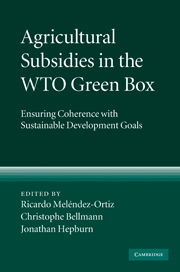Book contents
- Frontmatter
- Contents
- List of contributors
- Preface
- Acknowledgements
- List of abbreviations
- 1 Overview
- PART I The recent evolution of agricultural trade policy reform
- PART II The focus, extent and economic impact of green box subsidies
- 7 An analysis of EU, US and Japanese green box spending
- 8 Green box subsidies and trade-distorting support: is there a cumulative impact?
- 9 The distributional structure of green box subsidies in the European Union and France
- 10 The distributional structure of US green box subsidies
- PART III Green box subsidies and developing countries
- PART IV Green box subsidies and the environment
- PART V Looking forward: how can change take place?
- Appendix: Text of Annex 2 of the WTO Agreement on Agriculture (“the green box”)
- Index
- References
8 - Green box subsidies and trade-distorting support: is there a cumulative impact?
from PART II - The focus, extent and economic impact of green box subsidies
Published online by Cambridge University Press: 03 May 2010
- Frontmatter
- Contents
- List of contributors
- Preface
- Acknowledgements
- List of abbreviations
- 1 Overview
- PART I The recent evolution of agricultural trade policy reform
- PART II The focus, extent and economic impact of green box subsidies
- 7 An analysis of EU, US and Japanese green box spending
- 8 Green box subsidies and trade-distorting support: is there a cumulative impact?
- 9 The distributional structure of green box subsidies in the European Union and France
- 10 The distributional structure of US green box subsidies
- PART III Green box subsidies and developing countries
- PART IV Green box subsidies and the environment
- PART V Looking forward: how can change take place?
- Appendix: Text of Annex 2 of the WTO Agreement on Agriculture (“the green box”)
- Index
- References
Summary
Introduction
In the General Agreement of Tariffs and Trade (GATT), and now in the World Trade Organization (WTO), members have been constructing a set of rules and regulations to limit trade policies and other policies with equivalent effects – that is, policies that favour local production instead of the purchase of imported products.
GATT rules first put limits on subsidies for industrial products, and then prohibited them. For agricultural products, limits appeared for the first time in the Uruguay Round. Because agricultural subsidies were limited but not prohibited, agriculture was incorporated into the multilateral rules in a privileged way.
In the Agreement on Agriculture (AoA) approved during the Uruguay Round, agricultural subsidies were classified into different “boxes” according to their influence on producers' decisions.
Since 1994, the terms “amber”, “blue” and “green” have been used to describe the different kinds of support. The original idea was to repeat the colours of traffic lights – red for prohibited subsidies, yellow for limited subsidies and green for permitted subsidies – but a softer treatment prevailed.
The amber box includes measures related to production level or selling price; these payments are limited rather than prohibited, and a compromise for reducing them was agreed. The AoA also created a special category of amber box measures excluded from the reduction commitments because of their low level: de minimis payments. The blue box includes direct payments – like those included in the amber box – but “under production-limiting programmes” and was not subject to reduction commitments.
- Type
- Chapter
- Information
- Agricultural Subsidies in the WTO Green BoxEnsuring Coherence with Sustainable Development Goals, pp. 239 - 257Publisher: Cambridge University PressPrint publication year: 2009
References
- 1
- Cited by

